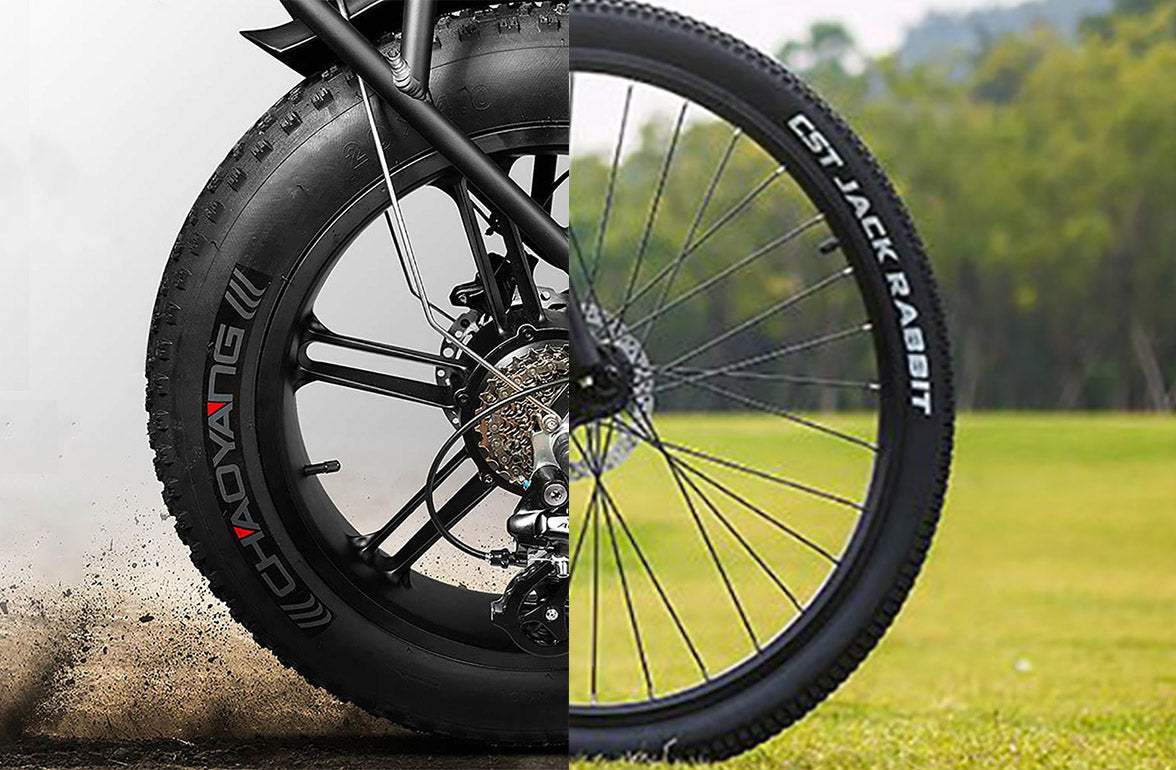Choosing an e-bike is an exciting step toward freedom, fitness, and fun—but with so many options, it’s easy to feel overwhelmed. One critical decision often sparks debate among riders: fat tires or thin tires? Each type caters to distinct riding styles, terrains, and priorities. Whether you’re a speed-loving urban commuter or an off-road adventurer, understanding these differences will help you pick the perfect e-bike. Let’s break down the pros, cons, and ideal scenarios for each tire type.
The Need for Speed: Why Thin Tire E-Bikes Shine
Thin-tire e-bikes, with their sleek, narrow profiles (typically 1.5–2.5 inches wide), are the Ferraris of the cycling world—built for efficiency and agility. Here’s what makes them stand out:
1. Built for Urban Warriors
-
Speed Demons: Thin tires have lower rolling resistance, letting you glide effortlessly on paved roads. With an electric motor amplifying your pedaling, you’ll zip through city streets faster than traffic.
-
Lightweight Agility: These bikes are lighter, making them easier to maneuver through tight spaces, sharp turns, and crowded bike lanes. Perfect for dodging pedestrians or hopping curbs.
-
Aerodynamic Edge: The slim design cuts through wind resistance, maximizing battery efficiency and extending your range—ideal for longer commutes.
Perfect For: Daily commuters, fitness riders, or anyone craving a sporty, responsive ride on smooth surfaces.
2. Trade-Offs to Consider
-
Rough Roads = Rough Rides: Thin tires sacrifice comfort on uneven terrain. Potholes and cracks can feel jarring due to minimal shock absorption.
-
Traction Troubles: On wet pavement, gravel, or dirt, the narrow contact patch may reduce grip, demanding extra caution.
-
No Off-Road Glory: These bikes aren’t designed for trails. Stick to pavement, or risk instability and discomfort.
Pro Tip: Pair thin tires with a suspension seat post to soften bumps without losing speed.
Conquer Every Landscape: The Power of Fat Tire E-Bikes
Fat-tire e-bikes, with their 3.8–5-inch-wide tires, are the SUVs of the e-bike world—unstoppable on rough terrain and built for exploration. Here’s why they’re gaining fans:
1. Adventure, Unleashed
-
All-Terrain Dominance: From sandy beaches to snowy trails, fat tires float over obstacles. The massive surface area grips loose surfaces, while the low tire pressure acts like a natural suspension.
-
Comfort, Redefined: Say goodbye to spine-rattling bumps. Fat tires absorb shocks, offering a plush ride even on rocky paths or cobblestones.
Perfect For: Off-road enthusiasts, winter riders, beach cruisers, or anyone prioritizing comfort over speed.
2. Trade-Offs to Consider
-
Weighty Reality: Fat tires add bulk. The bike will be heavier, requiring more effort to pedal without motor assistance.
-
Speed Limits: The increased rolling resistance means slower acceleration and lower top speeds compared to thin-tire models.
-
Battery Drain: Heavier tires and terrain challenges can reduce your e-bike’s range. Opt for a high-capacity battery if you plan long adventures.
Pro Tip: For mixed use, try hybrid tires—slightly narrower than fat tires but wider than traditional ones—to balance speed and stability.
Key Factors to Decide
1. Where Will You Ride?
-
Pavement Princess: Choose thin tires for cities, suburbs, or well-maintained bike paths.
-
Dirt Devil: Pick fat tires for trails, sand, snow, or unpredictable terrain.
2. What’s Your Riding Style?
-
Speed & Efficiency: Thin tires excel for racing, fitness, or daily commutes.
-
Leisure & Exploration: Fat tires prioritize comfort, stability, and versatility.
Beyond the Tires: Hidden Considerations
1. Maintenance Matters
-
Fat Tires: Require regular pressure checks (often 5–15 PSI) to maintain their cushioning effect. Watch for punctures—their size makes repairs trickier.
-
Thin Tires: Easier to repair but more prone to pinch flats on rough roads. Keep them inflated to 40–70 PSI for optimal performance.
2. Seasonal Smarts
-
Winter Warriors: Fat tires grip snow and ice like nothing else. Add studs for icy conditions.
-
Summer Speedsters: Thin tires shine in dry, warm weather but struggle in mud or rain.
3. Customization Options
-
Swap Tires: Some e-bikes allow tire changes. Try hybrid or all-season tires if your needs vary.
-
Accessorize: Add racks, fenders, or suspension seats to enhance comfort and utility.
Make Your Own Choice
The fat vs. thin tire debate isn’t about superiority—it’s about synergy with your lifestyle.
-
Choose Thin Tires If: You crave speed, ride mostly on pavement, or want a lightweight, agile e-bike for fitness or commuting.
-
Choose Fat Tires If: Adventure calls, comfort is king, or you face unpredictable terrain.
Conclusion
Ready to ride? The fat tires and thin tires respectively have advantages and disadvantages. Remember, the best e-bike isn’t the fastest or toughest—it’s the one that makes every ride feel like freedom. At DCCED, we offer models for every rider. Explore our sleek urban e-bikes with razor-thin tires or our rugged fat-tire beasts built to conquer mountains.










